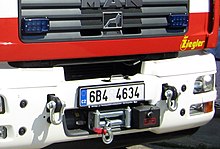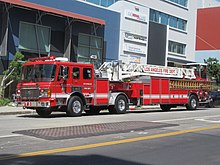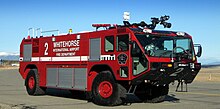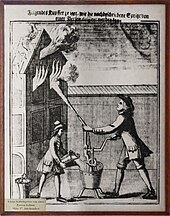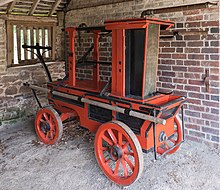
A water tender, sometimes known as a water tanker, is a type of firefighting apparatus that specializes in the transport of water from a water source to a fire scene. Water tenders are capable of drafting water from a stream, lake or hydrant.
Firefighting jargon includes a diverse lexicon of both common and idiosyncratic terms. One problem that exists in trying to create a list such as this is that much of the terminology used by a particular department is specifically defined in their particular standing operating procedures, such that two departments may have completely different terms for the same thing. For example, depending on whom one asks, a safety team may be referred to as a standby, a RIT or RIG or RIC, or a FAST. Furthermore, a department may change a definition within its SOP, such that one year it may be RIT, and the next RIG or RIC.
This is a glossary of firefighting equipment.

Pierce Manufacturing is a U.S. company based in Appleton, Wisconsin that manufactures customized fire and rescue apparatus. A wholly owned subsidiary of Oshkosh Corporation, Pierce was acquired in 1996. It is currently one of the largest fire apparatus company in the US. The company was founded in 1913 by Humphrey Pierce and his son Dudley as the Pierce Auto Body Works Inc., and concentrated on building custom truck bodies for the Ford Model T. The first production facility was designed in 1917 and enlarged in 1918 by architect Wallace W. DeLong. From the 1960s to the early 1980s, Pierce was primarily known for building custom bodies on commercial and other manufacturer's custom chassis, and was considered an original equipment manufacturer (OEM).

The Los Angeles County Fire Department (LACoFD) provides firefighting and emergency medical services for the unincorporated parts of Los Angeles County, California, as well as 59 cities through contracting, including the city of La Habra, which is located in Orange County and is the first city outside of Los Angeles County to contract with LACoFD.
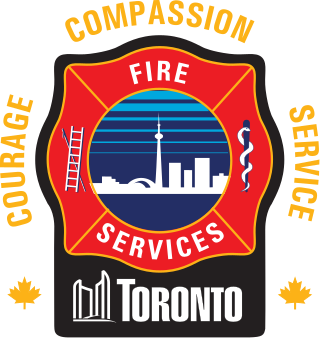
Toronto Fire Services (TFS), commonly called Toronto Fire, provides fire protection, technical rescue services, hazardous materials response, and first responder emergency medical assistance in Toronto, Ontario, Canada. Toronto Fire Services is currently the largest municipal fire department in Canada.
The New Zealand Fire Service was New Zealand's main firefighting body from 1 April 1976 until 1 July 2017 – at which point it was dissolved and incorporated into the new Fire and Emergency New Zealand.
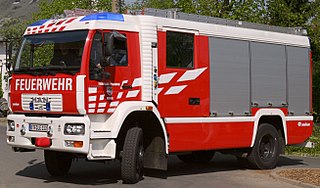
The Feuerwehr is a number of German fire departments. The responsible bodies for operating and equipping fire departments are the German communities ("Gemeinden") and cities ("Städte"). By law, they are required to operate fire-fighting forces. In cities, this is usually performed by the Fire Prevention Bureau, one of the higher-ranking authorities.

Palm Beach County Fire Rescue (PBCFR) is one of the largest fire departments in the state of Florida. With 52 stations, Palm Beach County Fire Rescue provides fire protection, Advanced Life Support, emergency medical services, technical rescue, hazardous materials' mitigation, aircraft rescue/firefighting, fire investigation, and 911 dispatching for unincorporated parts of Palm Beach County, Florida as well as 19 cities under contract.

A wildland fire engine or brush truck is a fire engine specifically designed to assist in fighting wildfires by transporting firefighters to the scene and providing them with access to the fire, along with water or other equipment. There are multiple types of wildfire apparatus which are used in different scenarios. According to the U.S. National Fire Protection Association, if the apparatus will be used primarily for outdoor and wildland responses, then it is to be considered a wildland fire apparatus and must conform to NFPA 1906.
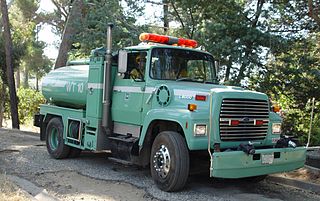
A wildland water tender is a specialized vehicle capable of bringing water, foam, or dry chemicals to fire trucks in the field that are engaged on the fireline. Water tenders have a large truck mounted tank that carries a minimum 1,000 gallons and up to 4,000 gallons of water. These vehicles are specifically designed for fire fighting often with four-wheel drive, rugged suspension and high wheel clearance for mountainous dirt road conditions. According to the National Fire Protection Association, if the apparatus will be used primarily for outdoor and wildland responses, then it is to be considered a wildland fire apparatus and must conform to NFPA 1906.
The San Diego Fire-Rescue Department (SDFD) is an all-risk, all-hazards fire department, providing fire protection and emergency medical services to the city of San Diego, California, United States. The San Diego Fire-Rescue Department is the second-largest municipal fire department in the state of California, after Los Angeles and responds to nearly 162,000 calls per year. The San Diego Fire-Rescue Department covers 343 square miles of service area including 17 miles of coastline, with responsibility extending 3 miles offshore.

Sutphen is an emergency services vehicle manufacturer and marketer based in Amlin, Ohio. Sutphen was founded in 1890 by C.H. Sutphen. The company has four manufacturing plants in Dublin, Amlin, Hilliard, Springfield Ohio and Lake Ariel, PA.
Firefighting is the act of extinguishing destructive fires. A firefighter fights these fires with the intent to prevent destruction of life, property and the environment. Firefighting is a highly technical profession, which requires years of training and education in order to become proficient. A fire can rapidly spread and endanger many lives; however, with modern firefighting techniques, catastrophe can usually be avoided. To help prevent fires from starting, a firefighter's duties include public education and conducting fire inspections. Because firefighters are often the first responders to victims in critical conditions, firefighters often also provide basic life support as emergency medical technicians or advanced life support as licensed paramedics. Firefighters make up one of the major emergency services, along with the emergency medical service, the police, and many others.

Flexible suction hose, not to be confused with hard suction hose in U.S., is a specific type of fire hose used in drafting operations, when a fire engine uses a vacuum to draw water from a portable water tank, pool, or other static water source. It is built to withstand vacuum, rather than pressure, abrasion, and heat. Conversely, hard suction is capable of withstanding up to 200 PSIG, as well as vacuum. In the United States, it is standard equipment according to the National Fire Protection Association standards for fire engines. It is used in both structural and wildland firefighting throughout the world, and is made in various diameters and connection types.

Fire services in the United Kingdom use a variety of fire appliances, which perform a wide range of general and specialised roles and fit into several distinct categories. Contemporary fire appliances carry a multitude of equipment and firefighting media to deal with different types of emergencies ranging from fires, rescues, vehicle extrication, floods, salvage, casualty and trauma care.

Firefighting in the United States dates back to the earliest European colonies in the Americas. Early firefighters were simply community members who would respond to neighborhood fires with buckets. The first dedicated volunteer fire brigade was established in 1736 in Philadelphia. These volunteer companies were often paid by insurance companies in return for protecting their clients.

The Baltimore City Fire Department (BCFD) provides fire protection and emergency medical services to the city of Baltimore, Maryland, United States. Founded in 1797 and established in 1859, the Baltimore City Fire Department covers an area of 81 square miles (210 km2) of land and 11 square miles (28 km2) of water, with a resident population of over 640,000 and a daytime population of over 1,000,000. The BCFD responds to approximately 235,000 emergency calls annually. There are two International Association of Fire Fighters (IAFF) locals; IAFF 734 for firefighters and IAFF 964 for officers.
The San Rafael Fire Department (SRFD) provides fire and emergency medical services to the City of San Rafael, California. The San Rafael Fire Department serves an estimated population of 72,000 people with approximately 70 firefighting and emergency medical field personnel. The ISO Class 1 department responds to, on average, approximately 9,000 emergency calls annually, with about 70% being emergency medical calls. EMS patients are transported to the hospital of their choice, unless the call is urgent.

A firefighting apparatus or firefighting appliance describes any vehicle that has been customized for use during firefighting operations. These vehicles are highly customized depending on their needs and the duty they will be performing. These duties can include firefighting and emergency medical services.

